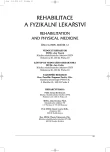Standing up from the Sitting Position in Clinical Practice
Authors:
D. Smékal 1; J. Opavský 1; J. Urban 1; M. Mayer 1,2
Authors‘ workplace:
Katedra fyzioterapie, Fakulta tělesné kultury, Olomouc
vedoucí prof. MUDr. J. Opavský, CSc.
1; Klinika rehabilitačního a tělovýchovného lékařství, Fakultní nemocnice, Olomouc
přednosta doc. MUDr. Č. Číhalík, CSc.
2
Published in:
Rehabil. fyz. Lék., 12, 2005, No. 2, pp. 55-61.
Category:
Original Papers
Overview
This paper deals with the biomechanics and neurophysiology of standing up from the sitting position. This movement pattern is divided into stages. The timing of the activity of individual muscles during each stage and the characteristic course of standing up from the sitting position are described. The main factors determining the characteristic timing of this pattern and the momentum of the key joints are discussed. These factors are the position of the legs, the height of the chair and the way the arms are used.
Key words:
sit-to-stand, interfering factors
Labels
Physiotherapist, university degree Rehabilitation Sports medicineArticle was published in
Rehabilitation & Physical Medicine

2005 Issue 2
Most read in this issue
- Painful Dysfunction Syndromes of the Shoulder: The Role of Short Depressors of the Humeral Head
- Standing up from the Sitting Position in Clinical Practice
- McKenzie Mechanical Diagnosis of Functional Syndromes of the Musculoskeletal System
- Dynamics of Functional Muscle Changes in Young Tennis Players
